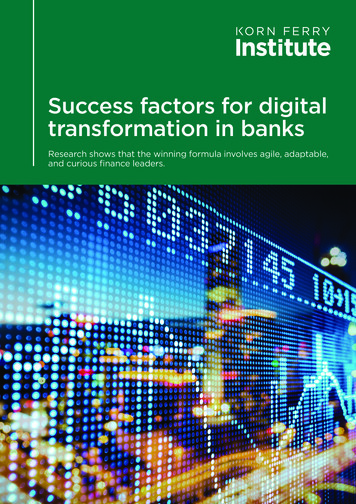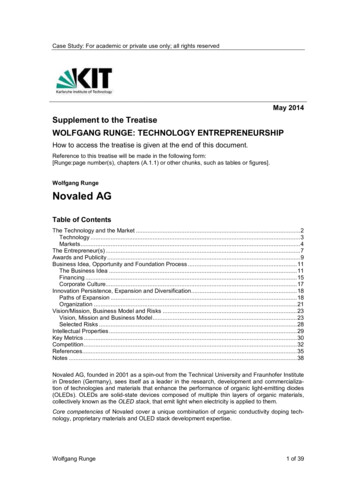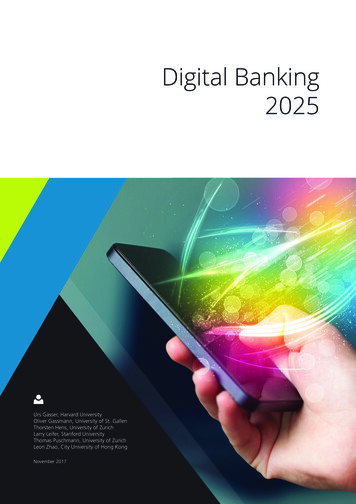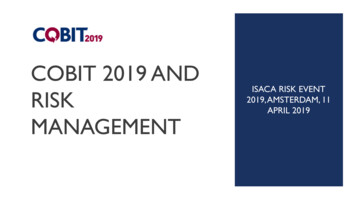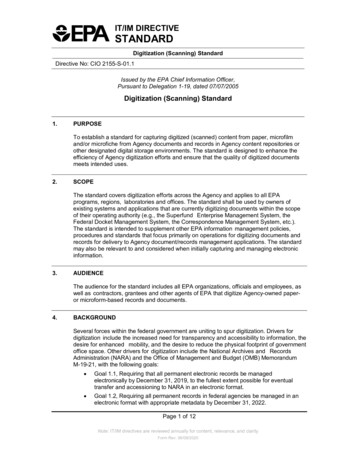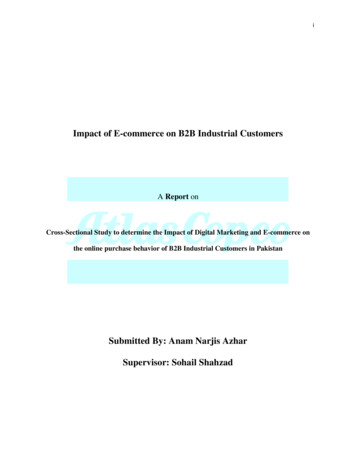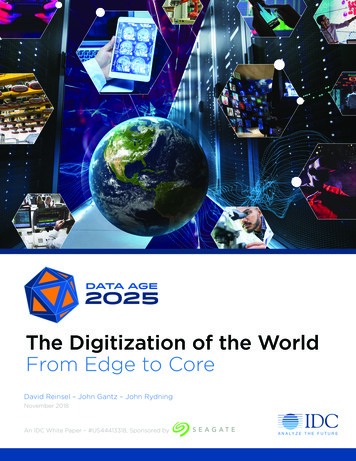
Transcription
The Digitization of the WorldFrom Edge to CoreDavid Reinsel – John Gantz – John RydningNovember 2018An IDC White Paper – #US44413318, Sponsored byA N A LY Z E T H E F U T U R E
Executive SummaryMankind is on a quest todigitize the worldThe focus of this digitization is anything and everything that intersects ourbusiness workflows and personal streams of life.This process of digitization is often referred towill drive even more automation intoas digital transformation, and it is profoundlybusinesses and feed processes andchanging the shape of business today,engagements that will deliver new levels ofimpacting companies in every industry andefficiency and products that are tailored toconsumers around the world. Digitalbusiness outcomes and individual customertransformation is not about the evolution ofpreferences.devices (though they will evolve), it is aboutthe integration of intelligent data intoTraditional paradigms will be redefinedeverything that we do.(like vehicle or white goods ownership) andethical, moral and societal norms will beThe data-driven world will be always on,challenged as genomics and advanced DNAalways tracking, always monitoring, alwaysprofiling influence healthcare directives,listening, and always watching – because it willinsurance premiums, and spousal choices.be always learning. What we perceive to beEntertainment will literally be transformedrandomness will be bounded into patterns ofbefore our eyes as virtual reality technologiesnormality by sophisticated artificial intelligencetransport us into new digital realities andalgorithms that will deliver the future in newaugmented reality will dramatically changeand personalized ways. Artificial intelligencethe service industry as we know it today.The data-driven world will be always on,always tracking, always monitoring, always listening andalways watching – because it will be always learning.IDC White Paper I Doc# US44413318 I November 2018The Digitization of the World – From Edge to Core I 2
Data is at the heart of digital transformation,consumers were responsible for much of theirthe lifeblood of this digitization process.own data, but their reliance on and trust ofToday, companies are leveraging data totoday’s cloud services, especially fromimprove customer experiences, open newconnectivity, performance, and conveniencemarkets, make employees and processes moreperspectives, continues to increase while theproductive, and create new sources ofneed to store and manage data locallycompetitive advantage – working toward thecontinues to decrease. Moreover, businessesfuture of tomorrow.are looking to centralize data managementand delivery (e.g., online video streaming,Global Datasphere expansion isnever-endingdata analytics, data security, and privacy) asIDC has defined three primary locations wherebusinesses and the user experiencedigitization is happening and where digital(e.g., machine-to-machine communication,content is created: the core (traditional andIoT, persistent personalization profiling). Thecloud datacenters), the edgeresponsibility to maintain and manage all this(enterprise-hardened infrastructure like cellconsumer and business data supports thetowers and branch offices), and the endpointsgrowth in cloud provider datacenters. As a(PCs, smart phones, and IoT devices). Theresult, the enterprise’s role as a data stewardsummation of all this data, whether it iscontinues to grow, and consumers are notcreated, captured, or replicated, is called thejust allowing this, but expecting it. BeginningGlobal Datasphere, and it is experiencingin 2019, more data will be stored in thetremendous growth. IDC predicts that theenterprise core than in all the world'sGlobal Datasphere will grow from 33existing endpoints.well as to leverage data to control theirZettabytes (ZB) in 2018 to 175 ZB by 2025.To keep up with the storage demandsstemming from all this data creation, IDCforecasts that over 22 ZB of storage capacitymust ship across all media types from 2018 to2025, with nearly 59% of that capacitysupplied from the HDD industry.An enterprise renaissance is on thehorizonThe enterprise is fast becoming the world'sdata steward again. In the recent past,IDC White Paper I Doc# US44413318 I November 2018IDC predicts thatthe Global Dataspherewill grow from33 Zettabytesin 2018 to175 Zettabytesby 2025The Digitization of the World – From Edge to Core I 3
Cloud is the new coremanufacturing and financial services are theOne of the key drivers of growth in the core isleading industries in terms of maturity, withthe shift to the cloud from traditionalmedia and entertainment most in need of adatacenters. As companies continue to pursuejump start.the cloud (both public and private) for databecoming the new enterprise data repository.China's Datasphere on pace tobecoming the largest in the worldIn essence, the cloud is becoming the new core.Every geographic region has its ownIn 2025 IDC predicts that 49% of the world’sDatasphere size and trajectories that arestored data will reside in public cloudimpacted by population, digitalenvironments.transformation progress, IT spend andprocessing needs, cloud datacenters arematurity, and many other metrics. ForIntroducing the world's first datareadiness condition (DATCON) indexexample, China’s Datasphere is expected toNot all industries are prepared for theirand will be the largest Datasphere of alldigitally transformed future. So, to helpregions by 2025 (compared to EMEA, APJxC,companies understand their level of dataU.S., and Rest of World) as its connectedreadiness, IDC developed a DATCON (DATapopulation grows and its video surveillancereadiness CONdition) index, designed toinfrastructure proliferates. (APJxC includesanalyze various industries regarding their ownAsia-Pacific countries, including Japan, butDatasphere, level of data management, usage,not China.)leadership, and monetization capabilities. IDCgrow 30% on average over the next 7 yearsanalysis: financial services, manufacturing,Consumers are addicted to data,and more of it in real-timehealthcare, and media and entertainment.As companies increase the digitization of theirManufacturing’s Datasphere is by far thebusiness and drive consistent and betterlargest given its maturity, investment in IoT,customer experiences, consumers areand 24x7 operations, and we found thatembracing these personalized real-timeexamined four industries as part of its DATCONIn 2025IDC predictsthat49IDC White Paper I Doc# US44413318 I November 2018%of the world’s storeddata will reside in publiccloud environmentsThe Digitization of the World – From Edge to Core I 4
engagements and resetting their expectationshave data infrastructures that can meet thisfor data delivery. As their digital worldgrowth in real-time data.overlaps with their physical realities, theyexpect to access products and servicesToday, more than 5 billion consumers interactwherever they are, over whatever connectionwith data every day – by 2025, that numberthey have, and on any device. They want datawill be 6 billion, or 75% of the world'sin the moment, on the go, and personalized.population. In 2025, each connected personThis places greater demand on both the edgewill have at least one data interaction everyand the core to be able to produce the18 seconds. Many of these interactions areprecise data consumers require, often inbecause of the billions of IoT devicesreal-time. IDC predicts that due to the infusionconnected across the globe, which areof data into our business workflows andexpected to create over 90ZB of data in 2025.personal streams of life, that nearly 30% ofthe Global Datasphere will be real-time by2025. Enterprises looking to provide superiorcustomer experience and grow share mustAbout this studyThis study is based on IDC’s ongoing GlobalDataSphere research and market sizing models.Industry and specific geographic Datasphereresearch was conducted in September 2018 byIDC. In addition, 2,400 enterprise decisionmakers were surveyed, and in-depth interviewswere conducted with senior IT executives at avariety of industries to inform this study. Thesurvey was with decision makers who hadresponsibility for or knowledge of theirorganization’s use, management, and storage ofdata leveraging advanced technologies includingInternet of Things, real-time analytics, andAI/machine learning. The survey spanned severalcountries and regions including the UnitedStates, China, EMEA, APJxC, and others.IDC White Paper I Doc# US44413318 I November 2018The Digitization of the World – From Edge to Core I 5
Chapter 1 Characterizing the Global DatasphereGlobal Datasphere Expansionis Never-endingThe use of data today is transforming the way wecompanies capture, catalog, and cash in on datalive, work, and play. Businesses in industriesin every step of their supply chain; enterprisesaround the world are using data to transformcollect vast sums of customer data to providethemselves to become more agile, improvegreater levels of personalization; and consumerscustomer experience, introduce new businessintegrate social media, entertainment, cloudmodels, and develop new sources of competitivestorage, and real-time personalized services intoadvantage. Consumers are living in antheir streams of life.increasingly digital world, depending on onlineThe consequence of this increasing reliance onand mobile channels to connect with friends anddata will be a never-ending expansion in the sizefamily, access goods and services, and run nearlyof the Global Datasphere. Estimated to be 33 ZBevery aspect of their lives, even while asleep.in 2018, IDC forecasts the Global Datasphere toMuch of today’s economy relies on data, and thisgrow to 175 ZB by 2025. (Figure 1). See Appendixreliance will only increase in the future asfor methodology and data/device categories.Figure 1 – Annual Size of the Global DatasphereAnnual Size of the Global Datasphere180175 ce: Data Age 2025, sponsored by Seagate with data from IDC Global DataSphere, Nov 2018MRI image creation is driving storage requirements significantly.The trend is more images with thinner slices and 3D capability.We've gone from 2,000 images to over 20,000 for an MRI of ahuman head, and stronger magnets and higher resolutionpictures means more data stored.– Senior Director in IT, Major Healthcare ProviderIDC White Paper I Doc# US44413318 I November 2018The Digitization of the World – From Edge to Core I 6
How big is 175ZB?One zettabyte is equivalent to a trillion gigabytesSometimes it can bedifficult to get our mindsaround such a large number.Here are some illustrations ofjust how large 175ZB is.If you were able to store the entire Global Datasphere onDVDs, then you would have a stack of DVDs that couldget you to the moon 23 times or circle Earth 222 times.If you could download the entire 2025 Global Datasphereat an average of 25 Mb/s, today's average connectionspeed across the United States, then it would take oneperson 1.8 billion years to do it, or if every person in theworld could help and never rest, then you could get itdone in 81 days.The Core is the Heart of the DatasphereIn this study we isolated three primary data location categories that make up the Datasphere:1. CoreThis consists of designated computing datacenters in the enterprise and cloud providers. Itincludes all varieties of cloud computing, including public, private, and hybrid cloud. It alsoincludes enterprise operational datacenters, such as those running the electric grid andtelephone networks.2. EdgeEdge refers to enterprise-hardened servers and appliances that are not in core datacenters. Thisincludes server rooms, servers in the field, cell towers, and smaller datacenters located regionallyand remotely for faster response times.3. EndpointEndpoints include all devices on the edge of the network, including PCs, phones, industrialsensors, connected cars, and wearables.A key aspect characterizing the Datasphere today is the increasingly critical role of the endpointsand edge – which is where all the digital data about us or for us is delivered to us to help informreal-time decisions, personalized services, or other latency-sensitive actions. Data gathered fromendpoints is collected at the edge, which is an important location for delivering the intelligenceand analytics necessary to provide faster response and better end-user experience, as well as toaccelerate and bring new levels of efficiency and quality to business.Use cases at the edge and core that illustrate their criticality are growing aggressively, with entirecategories yet to have even crossed our minds. One increasingly critical engagement betweenedge and endpoint is the connected car. Driven largely by the video captured and analyzed bynumerous cameras integrated into the vehicle, IDC estimates that an autonomous vehicle cancreate over 3TB of data per hour, and this doesn't include infotainment and GPS data. This datacreation will continue to increase as vehicle-to-vehicle communication becomes commonplace,and as machine learning and AI continuously update pattern recognition integrated into vehicles’intelligent driving algorithms.IDC White Paper I Doc# US44413318 I November 2018The Digitization of the World – From Edge to Core I 7
Manufacturers have long sensed and actuatedand intelligence throughout the network,on real-time data feeds within controlledpowering internal and external processes, asmanufacturing environments. This has led towell as intelligent and predictive engagementsbetter quality products at significantly lowerbetween businesses and individuals acrossprices. Companies are now looking to sense andentire ecosystems (Figure 2). The net effect isactuate on data collected outside the factorythe continued importance and growth inwalls, while products are being used.enterprise storage.Manufacturers can extend product life andFigure 2Data propagation from endpoints to core and backreduce product failures by understandingproduct performance in random environmentsE NDP OINTesiclhVeare embedded and connected in the everydayproducts that we use.Oanch fficesBrCOREIoTBOTregulatory compliance. As a result, datawToanalytics, command and control, andC ellarchiving, service delivery, deeper-levelerflows in a constant stream from endpointsand the edge to the core and back out tothe edge and endpoints, with each locationplaying an important part in the overallDatasphere. This propagation of data drives dataAR/VRayproviding centralized storage andsLargeDatacentersincludingPrivate & PublicCloudewcore. The core plays a critical role byMobileED GEutersmpCoBut the heart of the Datasphere is thePeoplesGaConnectedProcessestetsprofiles. This is now possible with sensors thatAssused by customers with a multitude of behaviorIAPgrowth in the core and has ramifications for analyticsSource: IDC’s Data Age 2025 study, sponsored by SeagateWe’ll have more intelligence and more activity at the edgeon data coming from the generators that we build and theIoT devices we have deployed raw data will be analyzedon the edge first, and then the results will be sent back tothe core for deeper analysis.– CISO/CFO, Leading Manufacturing FirmIDC White Paper I Doc# US44413318 I November 2018The Digitization of the World – From Edge to Core I 8
Data Created (Datasphere) is different than Data StoredFrom a data creation perspective (solid lines inthe core to be more than double the dataFigure 3), endpoints are declining as a percentstored in the endpoint, completely reversingwhile the core and edge continue to producethe dynamic from 2015. Edge storage will alsomore. From a data storage perspectivesee significant growth as latency-sensitive(dotted lines in Figure 3), the amount of dataservices and applications proliferatebeing stored in endpoints will plummet as thethroughout our world.core becomes the repository of choice for dataof all types. By 2024, we expect data stored inFigure 3 – Where data is created and storedCreating and Storing Data by 10%0%Core-Store2010 2011 2012 2013 2014 2015 2016 2017 2018 2019 2020 2021 2022 2023 2024 2025Source: Data Age 2025, sponsored by Seagate with data from IDC Global DataSphere, Nov 2018We are beginning to understand the value of datamining and being able to bring together disparatedata and systems that create that data. We don’tunderstand well enough how to do this in an efficient,cost-effective way. Right now, each system primarilycreates its own data; each system manages its owndata environment.– CISO/CFO, Leading Manufacturing FirmIDC White Paper I Doc# US44413318 I November 2018The Digitization of the World – From Edge to Core I 9
Cloud is the New Core and Much of it is AdditiveToday, as greater numbers of devices with greaterbytes will be stored in the public cloud than inlevels of intelligence are connected to variousconsumer devices (Figure 4), and by 2021, therenetworks, businesses and consumers are findingwill be more data stored in the public cloud thanthe cloud to be an increasingly attractive optionin traditional datacenters (Figure 5).that enables fast, ubiquitous access to their data.Increasingly, consumers are fine with lowerstorage capacity on endpoint devices in favor ofusing the cloud. By 2020, we believe that moreFigure 4 – Where is the data stored?70%Where is the data stored?60%50%Consumer %40%Enterprise %30%Public Cloud %20%10%0%2010 2011 2012 2013 2014 2015 2016 2017 2018 2019 2020 2021 2022 2023 2024 2025Source: Data Age 2025, sponsored by Seagate with data from IDC Global DataSphere, Nov 2018There is definitely interest in an increase in utilization ofpublic cloud for data stores as long as we’re good withgovernance and identify suitable candidates. It’s still notgoing to be customer data for the foreseeable future, butthere are candidates It’s fair to say that public cloudutilization is going to double.– VP of IT, Fortune 50 Financial Services FirmIDC White Paper I Doc# US44413318 I November 2018The Digitization of the World – From Edge to Core I 10
Figure 5 – Data Stored in Public Clouds Versus Traditional DatacentersData Stored in Public Clouds vs. Traditional Datacenters100%90%80%Enterprise Datacenters70%60%50%40%30%Public 019202020212022202320242025Source: Data Age 2025, sponsored by Seagate with data from IDC Global DataSphere, Nov 2018Business models and the location of dataThis is not necessarily an easy task given thatmanagement may be changing, but the technicalsome industries still have data in silos within therequirements and challenges remain. Data mustcorporate walls, as well as outside the corporatebe archived and stored in ways that providewalls residing in branch offices, contractor sites,appropriate levels of performance and enableor some other location where the data is notanalytics and intelligence to be applied to them,generally accessible.but it must be done cost-effectively and securely.There is a lot of data that has been done by third parties,and there’s a lot of data we own but it sits out with otherpeople. A big part is trying to figure out how we mightbring back that data and store it. We may not even knowwhat we need it for, but we need it stored in one place sothat others, like data scientists, can have access.– CIO and SVP of Corporate IT, Major Media FirmIDC White Paper I Doc# US44413318 I November 2018The Digitization of the World – From Edge to Core I 11
The Enterprise Datasphere and Stewardship is Vital to Our FutureThe enterprise continues to see its share ofincreasingly centralized across enterprise coreDatasphere stewardship grow, with consumers’and edge infrastructure, the responsibility toshare of data generated dropping from 47% inmaintain and manage it is shifting to2017 to 36% by 2025. This shift is largely drivenenterprise/cloud provider datacenters. Theby the increasingly always-on and “sensorized”enterprise is already the primary source andworld that is capturing and analyzing oursteward of data creation and storage, and theenvironments and creating data 24x7. In thetrend continues to amplify these responsibilitiespast, consumers were responsible for much of(Figures 6 and 7).their own data, but as data becomesFigure 6 and 7 – The Enterprise Datasphere Continues to Expand100%The Enterprise vs. Consumer %40%20%Enterprise70%60%30%Installed Base of Bytes by Owner30%Consumer20%10%Consumer10%0%2010 2011 2012 2013 2014 2015 2016 2017 2018 2019 2020 2021 2022 2023 2024 20250%2010 2011 2012 2013 2014 2015 2016 2017 2018 2019 2020 2021 2022 2023 2024 2025Source: Data Age 2025, sponsored by Seagate with data from IDC Global DataSphere, Nov 2018The installed bytes across the enterprise is expected to grow to 13.6ZB, representingover 80% of the worldwide installed bytes in 2025.We have initiatives partnering with facility management,micro payments, and car manufacturers. We currently have25 properties, so we leverage IoT to have efficientoptimization around datacenter and portfolio management.All of those are big sources of data ingest.– VP of IT, Fortune 50 Financial Services FirmIDC White Paper I Doc# US44413318 I November 2018The Digitization of the World – From Edge to Core I 12
Real-Time Data Demand is Driving the EdgeIDC forecasts that more than 150B devices willmanufacturing floor rely on real-time data forbe connected across the globe by 2025, mostprocess control and improvement. Real-timeof which will be creating data in real time. Fordata represents 15% of the Datasphere in 2017,example, automated machines on aand nearly 30% by 2025 (Figure 8).Figure 8 - Real-Time DataHow Much of Global Datasphere is % of GlobalDatasphereReal-Time Data5%0%2010 2011 2012 2013 2014 2015 2016 2017 2018 2019 2020 2021 2022 2023 2024 2025Source: Data Age 2025, sponsored by Seagate with data from IDC Global DataSphere, Nov 2018But it's not just machines that are drivingaverage will have a digital data engagementreal-time data. IDC estimates that by 2025,over 4,900 times per day – that's about 1 digitalevery connected person in the world oninteraction every 18 seconds (Figure 9).Figure 9 - Data Interactions per Connected Person Per DayThe Number of 4262,0001,00002982010584201520202025Source: Data Age 2025, sponsored by Seagate with data from IDC Global DataSphere, Nov 2018IDC White Paper I Doc# US44413318 I November 2018The Digitization of the World – From Edge to Core I 13
The Demand for Storage Remains StrongThe amount of data created in the GlobalIDC currently calculates Data Age 2025 storageDatasphere is, of course, the target for thecapacity shipments across all media types (HDD,storage industry. Even with the amount of dataSSD, NVM-flash/other, tape, and optical) over thecreated that is discarded, overwritten, or sensed,next 4 years (2018–2021) will need to exceed thebut never stored longer than milliseconds, there6.9ZB shipped across all media types over thestill exists a growing demand for storagepast 20 years. IDC forecasts that over 22ZB ofcapacity across industries, governments,storage capacity must ship across all mediaenterprises, and consumers.types from 2018 to 2025 to keep up with storagedemands. Around 59% of the capacity will needTo live in a digitized world where artificialto come from the HDD industry and 26% fromintelligence drives business processes, customerflash technology over that same time frame, withengagements, and autonomous infrastructure oroptical storage the only medium to show signswhere consumers' lives are hyper-personalized inof fatigue as consumers continue to abandonnearly every aspect of behavior – including whatDVDs in favor of streaming video and audiotime we'll be awakened based on the previous(Figure 10).day's activities, overnight sleep patterns, and thenext day's calendar – will require creating andstoring more data than ever before.Figure 10 - Worldwide Byte Shipments by Storage Media TypeWorldwide Byte Shipments by Storage Media ther2.01.5Optical1.0Tape0.502010 2011 2012 2013 2014 2015 2016 2017 2018 2019 2020 2021 2022 2023 2024 2025Source: Data Age 2025, sponsored by Seagate with data from IDC Global DataSphere, Nov 2018IDC White Paper I Doc# US44413318 I November 2018The Digitization of the World – From Edge to Core I 14
The growth in endpoint and edge storage willplaced on them. By the end of 2025, over 80%favor solid state, while the core continues toof the enterprise bytes shipped into the corehave a voracious appetite for the economicaland edge will continue to be HDD bytes whenbytes that hard disk drives and tape provide.compared to SSDs and other NVMEnterprises will use a mix of disk drives, SSDs,technologies (Figure 11).flash, and tape to satisfy the performance,management, and archive demands beingFigure 11 - Share Worldwide Byte Shipments into the Enterprise Core and Edge by Storage Media TypeShare Worldwide Byte Shipments into the EnterpriseCore and Edge by Storage Media %2010 2011 2012 2013 2014 2015 2016 2017 2018 2019 2020 2021 2022 2023 2024 2025Source: Data Age 2025, sponsored by Seagate with data from IDC Global DataSphere, Nov 2018By theend of 2025,over80%IDC White Paper I Doc# US44413318 I November 2018of the enterprise bytes shippedinto the core and edge willcontinue to be HDD bytes.The Digitization of the World – From Edge to Core I 15
Chapter 2 A Regional Perspective on the Global DatasphereRegional Dataspheres have theirown unique growth profileWhether population driven, application driven(e.g., video surveillance), or digitaltransformation maturity driven, any givencountry or region will have a differentDatasphere growth profile. Note that thecalculations in regional Dataspheres are based onwhere the devices are located from a regionalperspective, as opposed to who may actually ownthem. For example, if providers in the U.S. own andoperate datacenters in EMEA, the data createdand stored are part of the EMEA Datasphere.ChinaChina has the fastest growing Datasphere of all the regions forecast in this study. The rapiddeployment of video surveillance in China has catapulted the country’s use of enterprise storage,as well as a large share of endpoint data creation. China is also one of the fastest growing regionswhen it comes to the deployment of cloud.EMEAMuch of the growth in the EMEA Datasphere is a result of a massive population with associatedendpoint devices used to create and consume massive amounts of data, an already establishedbase of video surveillance infrastructure, and the initial impact of General Data ProtectionRegulation (GDPR) legislation that likely will result in a temporary increase of data until formaldata management practices are implemented fully.U.S.A.While the U.S. Datasphere continues to grow, it cedes share to the other regions due to its moremature state in cloud infrastructure and highly penetrated population from an endpoint perspective.APJxCThe Asia-Pacific region including Japan, but excluding China, has the second strongestDatasphere growth with respect to geographies analyzed in this study. Countries like Japan arespending aggressively on smart city initiatives, which are data-creation intense.IDC White Paper I Doc# US44413318 I November 2018The Digitization of the World – From Edge to Core I 16
Figure 12 looks at the absolute size of eachAPJxC, China, and ROW in terms of the shareregional Datasphere while Figure 13 representsof bytes generated.the Datasphere share of the U.S., EMEA,Figure 12 - Size and Growth of the Global Datasphere by Region200Global Datasphere by ROW402002010 2011 2012 2013 2014 2015 2016 2017 2018 2019 2020 2021 2022 2023 2024 2025Source: IDC’s Data Age 2025 study, sponsored by SeagateFigure 13 – Global Datasphere Share by RegionGlobal Datasphere Share by 0 2011 2012 2013 2014 2015 2016 2017 2018 2019 2020 2021 2022 2023 2024 2025Source: IDC’s Data Age 2025 study, sponsored by SeagateIDC White Paper I Doc# US44413318 I November 2018The Digitization of the World – From Edge to Core I 17
Cloud Growth Explodes Outside the United StatesAs the headquarters region for the leading globalcloud providers, the United States has traditionallyhad the lion’s share of cloud storage, followed byEMEA and APJxC. And while cloud storage in theUnited States will continue to grow, cloudstorage in other regions will grow even faster,fueled both by the desire to reduce latencyby locating data closer to the endconsumer, as well as corporate and regulatorymandates requiring data to be housed locallywithin different regions. The U.S. share of publiccloud storage will drop precipitously from 51% in2017 to 31% by 2025, while China’s share will morethan double from 6% to 13% (Figure 14).The U.S. share of public cloudstorage will drop precipitously51%31%inin20172025while China’s share will morethan double6%to13%Figure 14 - Cloud Storage Growth and Share by RegionCloud Storage Growth and Share by Region2015-2025 CAGR100%ROW – 50%China – 50%90%80%APJxC – 47 %70%60%ChinaEMEAAPJxC50%EMEA – 46 %40%30%USROWUS – 33 %20%10%0%2010 2011 2012 2013 2014 2015 2016 2017 2018 2019 2020 2021 2022 2023 2024 2025Source: IDC’s Data Age 2025 study, sponsored by SeagateIDC White Paper I Doc# US44413318 I November 2018The Digitization of the World – From Edge to Core I 18
China and Asia Pacific/Japan Have Edge in Data MaturityIDC’s global survey in support of this projectindicates that other regions are beginning toeclipse the U.S. in certain measures of datamaturity. In particu
(e.g., machine-to-machine communication, IoT, persistent personalization profiling). The responsibility to maintain and manage all this consumer and business data supports the growth in cloud provider datacenters. As a result, the enterprise’s role as a data steward continues to grow, an

